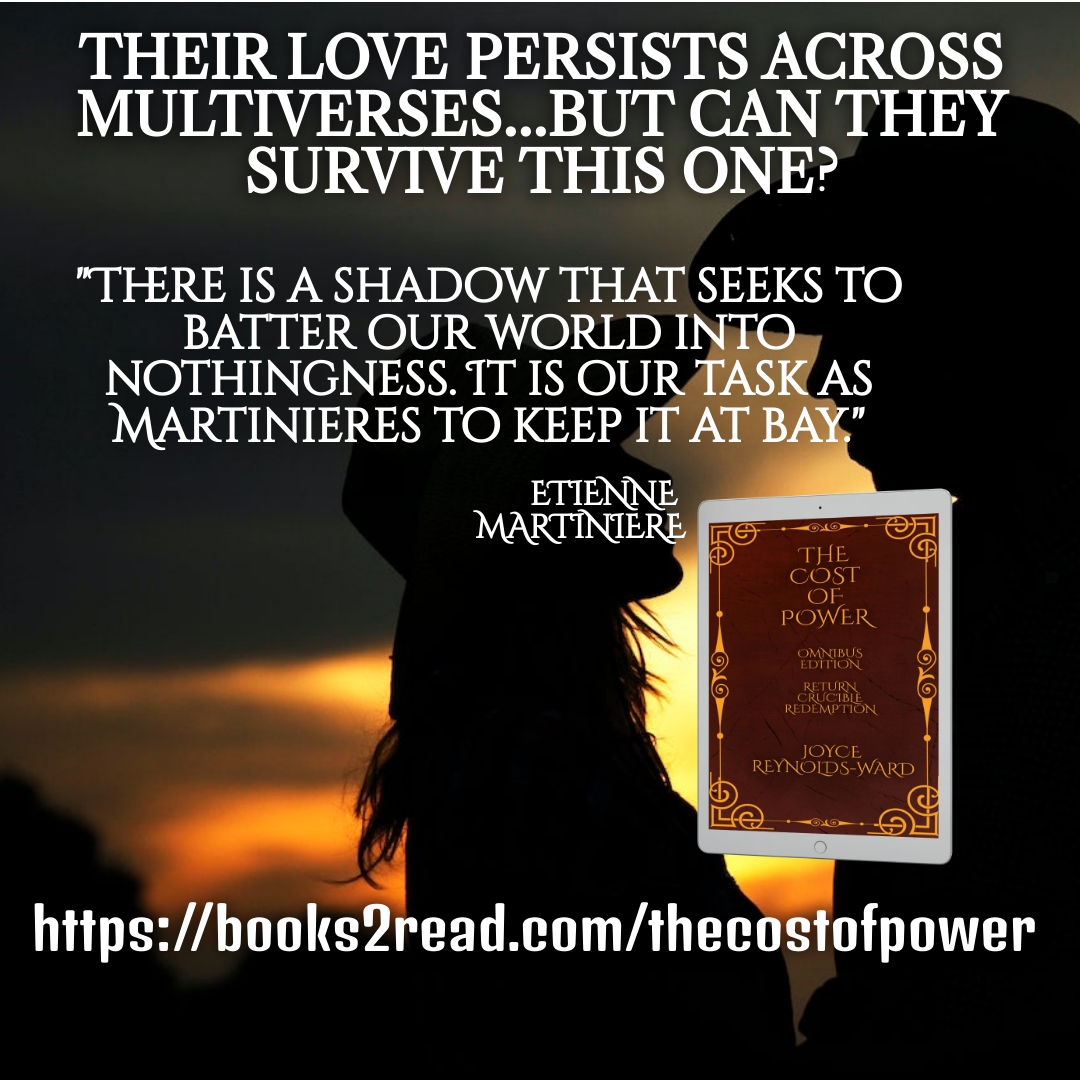
Welcome! This year I’m creating a set of posts/blogs/whatever you want to call them about the “story-behind-the story” for my backlist. This month, my final work (for now) in the Martiniere Family Saga—the story of one powerful family, across several universes is one of my featured series for discussion.
Housekeeping note: all related posts will be linked at the bottom.
###
“I’m sorry, Rubes. I have to go.”
“No. Gramps says we’ll figure out something to keep the three of us safe. Get Mike and Vickie to activate that Home Guard they’ve been talking about to protect us.” Her arms tightened around him. “Damn it, Gabe, no. Please. I love you.”
“I love you too, but it’s not safe for me to stay.”
“Bullshit. We’ll find a way, damn it, Gabriel Martiniere. If you run, it means that fucker wins. If I have to spend the rest of my life packing a weapon and watching our backs, so be it. I want you. Here. With me. Forever.”
The Cost of Power: Return
###
The Cost of Power. This trilogy has always been one that lurked at the back of my planning brain during the times I was writing what became the Martiniere Family Saga, especially as it evolved into a multiverse story. I had ambitious plans for Power and…I really didn’t achieve everything I wanted to do with it, in part because other notions crept in that blew the story up in a large fashion.
One of those pieces is the Carolingian element. It wasn’t until I neared the end of Book Three that I realized I had subconsciously been channeling pieces of The Song of Roland into the development of Gabriel Martiniere. I knew about the Melusine element and wrote it into the story early on, but the inciting feud between the Melusine and the Lorelei really didn’t come into shape until I consciously dredged up Roland as well as some other, related mythos tied to Ys and other European stories—and I will be the first to admit that my take is probably not as informed as it should be. I tend to dodge too much involvement in European-origin mythos because my personal connection to Europe is pretty tenuous after three hundred-or-so years of my family being in North America.
(That’s a discussion for another essay.)
Fortunately, I’d planned to release the trilogy after all three books were completed. I’d learned my lesson about dealing with continuity in both the Netwalk Sequence and Goddess’s Honor series, and had come to terms with the reality that no matter how careful my worldbuilding tends to be, the creative brain behind the characters ends up throwing me some curve balls later on which reveal motivations behind what happened earlier in the story that can significantly affect the early pieces of the plot.
My original notion, though, was an examination of just what power might cost those who achieve it. Ruby and Gabe pay a price big time in health, in challenges to their relationship, and in what they lose to balance out what they gain. While I wanted to explore impacts of the mind control technology developed by the Martinieres, I also wanted to consider redemptive elements.
###
Philip exhaled. “I’ve been a shit of a father. To you, Justine, and Joseph. I admit it. I probably will need to keep admitting it. I fucked you over worst of all, Gabriel. And for that, I am so, so fucking sorry. I just—I wanted you to be mine. When I saw just how much like me you already were, in all the ways I didn’t want to see myself replicated, I—” he raised his hands, a sad, defeated expression on his face. “I couldn’t stand it. I fucked up. I’m just grateful that you and Justine have turned out well, in spite of me.”
The Cost of Power: Return
Enter Power’s version of Philip Martiniere, Gabe’s father. In other Martiniere universes, Philip is vicious. Nasty. Downright evil. Narcissistic. Sociopathic.
You get the picture.
And yet—at times I got glimpses of Philip’s potential, even when writing him as someone awful. His clone, Mike, definitely showed that Philip didn’t have to be horrible. I decided that one of the secondary stories in Power would be Philip’s redemptive journey—tied to that mind control technology. But one of the pieces that also came out was the close relationship between Philip and his younger brother Gerard. Gerry acted as a modulating influence on Philip in the world of Power, providing him with a center that he didn’t have in other worlds.
The role of mind control technology, egged on more and more by supernatural and quasi-supernatural elements, grew bigger. The feud between two aristocratic families, the Martinieres and the Brauns, became a bigger element than existed in almost any other piece of the Martiniere Family Saga, except for A Different Life: What If?, where the Brauns first emerged as a major counterpoint to the Martinieres. Both families are somewhat the tools of tutelary spirits who play out their own feuds through their human descendants (the Martinieres, from the Melusine; the Brauns, from the Lorelei) over the span of centuries, going back to…the Carolingian era.
More and more pieces came together. A Cold War background to the current day feud between the Martinieres and the Brauns. The role of a distant ancestor, Etienne Martiniere, who escaped Napoleon by getting into the North American fur trade. Etienne’s enduring influence upon the Martinieres up to the present day. The creation of rituals that tie the generations of Martinieres together, including traditions such as the Family Call.
Who goes there?
Martinieres.
Who are the Martinieres?
We are the fighters!
What do the Martinieres do?
We stand and fight!
My notion of the Martinieres as a close-knit, aristocratic extended family with a tradition of being fighters and brawlers came to the fore. Ruby’s first exposure to just what becoming a Martiniere might mean is when she first sees Gabe initiating the Family Call to confirm the identity of the security force arriving to protect them. Developing that tradition explained a lot about Gabe’s upbringing, including military school, learning how to fight, and submitting to mind control programming as a means by Martiniere elders to manage their youngers, especially after the events of the 1960s and ‘70s.
But the existence of that sort of centuries-long aristocratic family tradition is also an element of this particular world. The world of Power, while it has many similarities to our own, has corporate power and influence being much more significant in ruling structures. Indentured servitude came about in the early 21st century. There’s also a powerful, toxic, religious cult known as the Electric Born with an elite subgroup called Heaven’s Reach that engages in massive genetic experimentation using elements stolen from the Martinieres, amongst other things.
Eventually, every major character in the book ends up dealing with their own relationship to power and what they’re willing to pay to gain it. Some end up submitting to a more powerful person—the villain Nathan Bonham is one of those. Another is Terence Braun, for whom the choice becomes power or close family. Not all are willing to pay the ultimate price, such as Gabe’s cousin Joey.
A significant piece of redemption in The Cost of Power is that everyone pays the price to achieve it—or else they’re ultimately doomed to fail. Gabe screws up in a particularly nasty way near the end of Book Two, Crucible. The price he pays for his mistakes is horrific but—he accepts it and works to expiate his wrongs. Philip has his own atonement arc.
But they aren’t the only ones…for there are digital thought clones who can cross universes, as can Fae spirits the Melusine and the Lorelei. Those beings end up dealing with their own payment for power, across the multiverse, in their own way.
How on earth could I manage to bring in fur trappers, mind control technology, digital thought clones, Fae, rodeo queens and more? I managed it…somehow. I’ve called The Cost of Power the book of my heart—and there’s a lot of truth to that statement. That said, it’s also somewhat a failed ambition, because while it’s probably one of the best things I’ve written, it’s also one of the most difficult to promote. I didn’t quite reach what I wanted in that book, but…I came close.
If you only read one thing in the Martiniere Family Saga, however, this trilogy is it.
The Cost of Power omnibus edition, including the books Return, Crucible, and Redemption as well as worldbuilding outtake snippets, is currently on sale in ebook for $3.99 at all major ebook outlets and can be requested through library apps.
I’d be honored if you checked it out.









